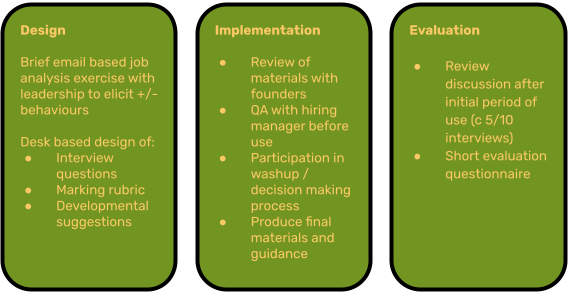Case Study - Defining - and hiring for - company values
The Client
FloodFlash provide event based flood cover to small businesses, enabled by cutting edge sensor technology and the Internet of Things (IoT).
The Challenge
Having successfully completed a Series A investment round, FloodFlash have growth firmly in their sights, including expansion into the critical United States market. Like many businesses entering this stage, FloodFlash founders, Adam and Ian, are thinking carefully about the behaviours that are going to push their business forward while preserving the aspects of the culture and working atmosphere that have served them well so far.
The Approach
The work with FloodFlash had two stages:
Stage 1: Providing support and challenge to Adam and Ian in articulating the FloodFlash values
Stage 2: Designing a structured interview assessment process that allows FloodFlash to evaluate and compare candidates in relation to their fit with the values
Stage 1 - Values articulation
At the stage I was brought in, Adam and Ian had already started working on their values. They had looked into other companies’ values to see what they liked and didn’t like, and they had already come up with an initial draft that covered broadly the right ground, but needed some work.
My role then was to:
Check alignment between the two founders around what was going to be important to FloodFlash
Offer my experience into the challenges and trade-offs in writing values (e.g. how many values, and what they are for)
Helping to reorganise the key behaviours into conceptually clear clusters
Drafting support to move the conversation forward
This resulted in a set of four values that were then shared and further refined with the FloodFlash leadership team.
Own the Outcome
Use Evidence
Be Helpful
Be Brave
Stage 2 - Structured Interview design and implementation
My role was to design and implement a structured interview process for FloodFlash values, which included:
Design of structured interview questions and scoring rubric
Support with integrating interview data with the overall decision making process
Suggestions for how to support successful candidates with developmental gaps
Design of a light touch evaluation framework for the process
The benefits of this approach were
A process that could be run by FloodFlash team members without significant training or support
Valuable additional data to the selection process
An approach informed by research and best practice in assessment, which leads to: more comparable data between candidates; more structured/informed judgements less influenced by bias and intuition
The Result
At present, FloodFlash are still only in the early stages of using this approach. In six months time we will start to examine whether judgements using the structured interview were borne out by successful candidates' performance on the job.
At this stage, the company Values are well received by candidates, and FloodFlash has created a video to help others understand why they are important.
In relation to the values assessment, FloodFlash are still only in the early stages of using this approach. In six months time we will start to examine whether judgements using the structured interview were borne out by successful candidates' performance on the job. However, anecdotal evidence suggests that the process has been well received by interviewers, decision makers, and also candidates. One candidate said that it was: “was my favourite of all the jobs I interviewed for”.
80% of interviewers found the first interaction of the process clear and easy to follow. 60% of decision makers found the data it provided useful. Some of the constructive feedback relates to restricted range in the scoring system, which we are currently re-evaluating.
Here’s a quote from Zara Kreimeia, People and Office Manager at FloodFlash: “Working with Rich has given us the opportunity and tools to really integrate our company values into our recruitment process, and build our team around the behaviours that are important to FloodFlash.”


